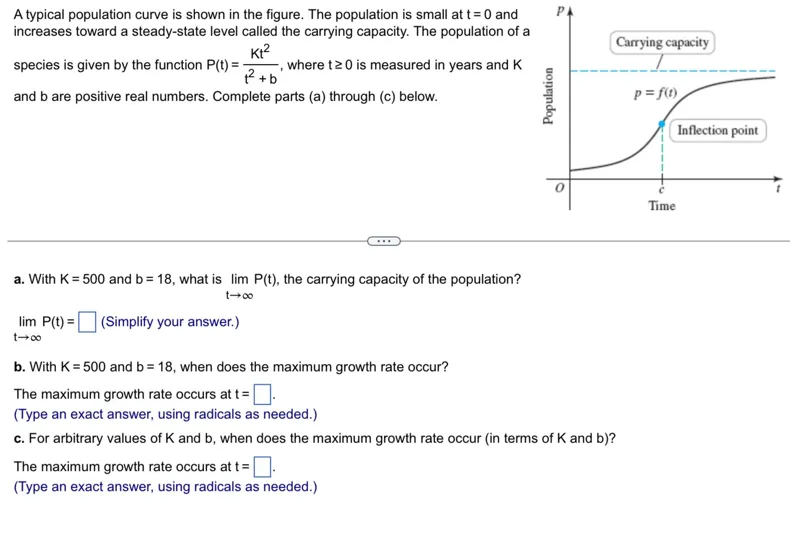Questions: A typical population curve is shown in the figure. The population is small at t=0 and increases toward a steady-state level called the carrying capacity. The population of a species is given by the function P(t) = K t² / (t² + b), where t ≥ 0 is measured in years and K and b are positive real numbers. Complete parts (a) through (c) below. a. With K=500 and b=18, what is lim t→∞ P(t), the carrying capacity of the population? lim t→∞ P(t) = (Simplify your answer.) b. With K=500 and b=18, when does the maximum growth rate occur? The maximum growth rate occurs at t= . (Type an exact answer, using radicals as needed.) c. For arbitrary values of K and b, when does the maximum growth rate occur (in terms of K and b)? The maximum growth rate occurs at t= . (Type an exact answer, using radicals as needed.)

Transcript text: A typical population curve is shown in the figure. The population is small at $t=0$ and increases toward a steady-state level called the carrying capacity. The population of a species is given by the function $P(t)=\frac{K t^{2}}{t^{2}+b}$, where $t \geq 0$ is measured in years and $K$ and b are positive real numbers. Complete parts (a) through (c) below.
a. With $K=500$ and $b=18$, what is $\lim _{t \rightarrow \infty} P(t)$, the carrying capacity of the population?
\[
\lim _{t \rightarrow \infty} P(t)=\square \text { (Simplify your answer.) }
\]
b. With $K=500$ and $b=18$, when does the maximum growth rate occur?
The maximum growth rate occurs at $\mathrm{t}=$ $\square$ .
(Type an exact answer, using radicals as needed.)
c. For arbitrary values of K and b, when does the maximum growth rate occur (in terms of K and b)?
The maximum growth rate occurs at $\mathrm{t}=$ $\square$ .
(Type an exact answer, using radicals as needed.)





